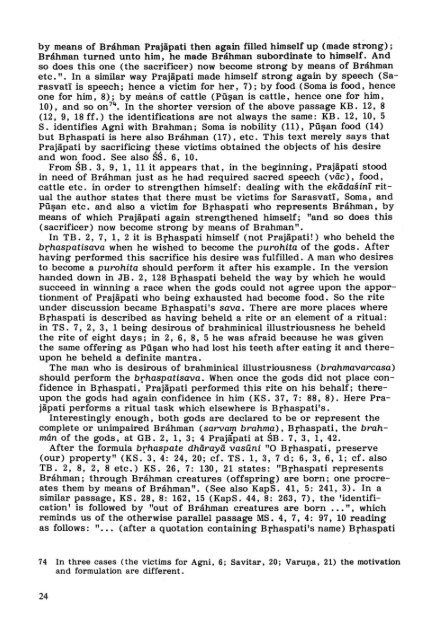Prajapati's relations with Brahman, Brhaspati and Brahma - DWC
Prajapati's relations with Brahman, Brhaspati and Brahma - DWC
Prajapati's relations with Brahman, Brhaspati and Brahma - DWC
You also want an ePaper? Increase the reach of your titles
YUMPU automatically turns print PDFs into web optimized ePapers that Google loves.
y means of Bráhman Prajäpati then again filled himself up (made strong);<br />
Bráhman turned unto him, he made Bráhman subordinate to himself. And<br />
so does this one (the sacrificer) now become strong by means of Bráhman<br />
etc. ". In a similar way Prajäpati made himself strong again by speech (Sarasvatï<br />
is speech; hence a victim for her, 7); by food (Soma is food, hence<br />
one for him, 8); by meáns of cattle (Pü!?an is cattle, hence one for him,<br />
10), <strong>and</strong> so on 7'+. In the shorter version oi the above passage KB. 12, 8<br />
(12,9, 18 ff.) the identifications are not always the same: KB. 12, 10, 5<br />
S. identifies Agni <strong>with</strong> <strong><strong>Brahma</strong>n</strong>; Soma is nobility (11), Pü!?an food (14)<br />
but <strong>Brhaspati</strong> is here also Bráhman (17), etc. This text merely says that<br />
Prajäpati by sacrificing these victims obtained the objects of his de sire<br />
<strong>and</strong> won food. See also SS. 6, 10.<br />
From SB. 3, 9, 1, 11 it appears that, in the beginning , Prajäpati stood<br />
in need of Bráhman just as he had required sacred speech (väc), food,<br />
cattle etc. in order to strengthen himself: dealing <strong>with</strong> the ekädasinï ritual<br />
the author states that there must be victims for Sarasvatï, Soma, <strong>and</strong><br />
Pü!?an etc. <strong>and</strong> also a victim for <strong>Brhaspati</strong> who represents Bráhman, by<br />
means of which Prajäpati again strengthened himself; "<strong>and</strong> so does this<br />
(sacrificer) now become strong by means of <strong><strong>Brahma</strong>n</strong>".<br />
In TB. 2, 7, 1, 2 it is <strong>Brhaspati</strong> himself (not Prajäpati!) who beheld the<br />
brhaspatisava when he wished to become the purohita of the gods. Af ter<br />
having performed this sacrifice his de sire was fulfilled. A man who desires<br />
to become a purohita should perform it af ter his example. In the version<br />
h<strong>and</strong>ed down in JB. 2, 128 <strong>Brhaspati</strong> beheld the way by which he ..... ould<br />
succeed in winning a race when the gods could not agree upon the apportionment<br />
of Prajäpati who being exhausted had become food. So the rite<br />
under discussion became <strong>Brhaspati</strong>'s sava. There are more places where<br />
<strong>Brhaspati</strong> is described as having beheld a rite or an element of a ritual:<br />
in T S. 7, 2, 3, 1 being desirous of brahminical illustriousness he beheld<br />
the rite of eight days; in 2, 6, 8, 5 he was afraid because he was given<br />
the same offering as Pü!?an who had lost his teeth af ter eating it <strong>and</strong> thereupon<br />
he beheld a definite mantra. ·<br />
The man who is desirous of brahminical illustriousness (brahmavarcasa)<br />
should perform the brhaspatisava. When once the gods did not place confidence<br />
in <strong>Brhaspati</strong>, Prajäpati performed this rite on his behalf; thereup<br />
on the gods had again confidence in him (KS. 37, 7: 88, 8). Here Prajäpati<br />
performs a ritual task which elsewhere is <strong>Brhaspati</strong>'s.<br />
Interestingly enough, both gods are declared to be or represent the<br />
complete or unimpaired Bráhman (sarva'!l brahm!l), <strong>Brhaspati</strong>, the brahmán<br />
of the gods, at GB. 2, 1, 3; 4 Prajäpati at SB. 7, 3, 1, 42.<br />
After the formula brhaspate dhärayä vasüni "0 <strong>Brhaspati</strong>, preserve<br />
(our) property" (KS. 3, 4:24, 20; cf. TS. 1,3, 7 d; 6,3,6, 1; cf. also<br />
TB. 2, 8, 2, 8 etc.) KS. 26, 7: 130,21 states: "<strong>Brhaspati</strong> represents<br />
Bráhman; through Bráhman creatures (offspring) are born; one procreates<br />
them by means of Bráhman". (See also KapS. 41, 5: 241,3). In a<br />
similar passage, KS. 28, 8: 162, 15 (KapS. 44, 8: 263, 7), the 'identification<br />
' is followed by "out of Bráhman creatures are born ... ", which<br />
reminds us of the otherwise parallel passage MS. 4, 7, 4: 97, 10 reading<br />
as follows: " ... (af ter a quotation containing <strong>Brhaspati</strong>'s name) <strong>Brhaspati</strong><br />
74 In three cases (the victims for Agni, 6; Savitar, 20; VaruQa, 21) the motivation<br />
<strong>and</strong> formulation are different.<br />
24
















